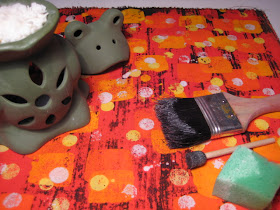Batik med sojavax
Den här veckan har jag experimenterat med batik och sojavax. Sojavax är ett miljövänligare alternativ när man vill jobba med vaxbatik. Det är lätt att applicera och relativt lätt att få bort när man är klar. Jag har ännu inte hunnit skaffa något mera avancerat kärl att smälta vaxet i, så jag använder mig av en lykta som egentligen är tänkt för doftolja. Den fungerar utmärkt så länge som jag inte behöver några stora mängder vax. ;-)
Det är kanske vanligast att man färgar tyget genom färgbad när man jobbar med batik, men i det här experimentet har jag prövat den teknik som Melanie Testa beskriver i Quilting Arts Magazine (nr 45, juni/juli 2010). Hon väter tyget efter att ha applicerat vaxet och målar det sedan med tygtrycksfärg. Efter att tyget har torkat kan man sedan applicera mera vax och färg på samma sätt, och fortsätta bygga upp lagren tills man är nöjd. Mitt tyg innehåller 5 målade färglager (gult, ljus orange, mörk orange, rött, svart; tyget var ursprungligen vitt). Jag applicerade ett nytt vax- och färglager varje kväll under en veckas tid. Sedan strök jag tyget mellan massor av tidningspapper för att få bort det mesta av vaxet och fixera färgen. Till slut tvättade jag tyget i hett vatten.
Soy Wax Batik
This week I've experimented with soy wax batik. Soy wax is a more environmentally friendly alternative when you want to work with batik. It's easy to apply and relatively easy to remove when you're finished. I haven't yet managed to get myself any more advanced pot to melt the wax in, so I use an oil warmer. It works like a charm as long as I don't need any greater quantities of wax. ;-)
It's probably more common to immersion dye the fabric when you work with batik, but in this experiment I tried the technique that Melanie Testa describes in Quilting Arts Magazine (issue 45, June/july 2010). She wets the fabric after she has applied the wax, and then paints it with fabric paints. When the fabric is dry, you can apply more wax and more paint in the same manner and continue building layers until you're satisfied. There are 5 painted layers in my fabric (yellow, light orange, dark orange, red and black; the original colour was white). I applied a new layer of wax and paint every evening during the week. After this, I ironed the fabric between many layers of newspaper to remove most of the wax and heat set the paint. Finally, I washed the fabric in hot water.
Redskapen - The tools
Det färdiga tyget - The finished cloth


It's beautiful. I have taken Melanie's soy wax batik class. She is a wonderful teacher and very talented.
ReplyDeleteAnnika, your fabric is beautiful. I love your background for your blog. Have a great week.
ReplyDeleteThanks for the suggestion, Melly!
ReplyDeleteI'm going to put this fabric to use next Friday, as I signed up for a box-making class earlier, and created this fabric with that class in mind. Therefore I'll wait until I've made the box before I submit any images. Mind you, to be on the safe side, I'll take a new picture (with higher resolution) of the fabric before the class, in case I make of mess of it. :D